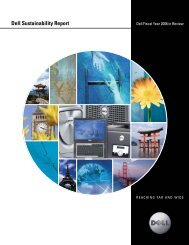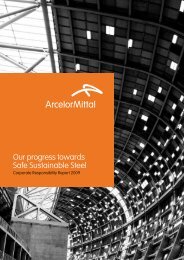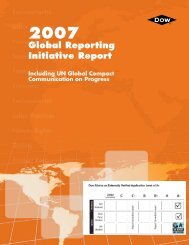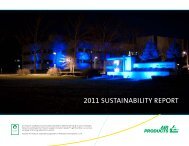Chevron Corporate Responsibility Report 2010
Chevron Corporate Responsibility Report 2010
Chevron Corporate Responsibility Report 2010
Create successful ePaper yourself
Turn your PDF publications into a flip-book with our unique Google optimized e-Paper software.
Notes to pages 38 and 39<br />
1 In <strong>2010</strong>, <strong>Chevron</strong> deployed a new greenhouse<br />
gas (GHG) and energy reporting system. The<br />
new system incorporates the reorganization of<br />
Global Downstream and emissions estimation<br />
methodologies from mandatory GHG reporting<br />
requirements imposed in the U.S. state<br />
of California and nationally in Australia, the<br />
European Union and the United States. Going<br />
forward, these systematic changes will make<br />
comparing emissions with years prior to <strong>2010</strong><br />
difficult. Nevertheless, the 2009 to <strong>2010</strong> net<br />
increase of approximately 2.2 million metric tons<br />
of CO 2 -equivalent emissions can be attributed<br />
to several factors. Beginning in <strong>2010</strong>, in conformance<br />
with industry best practices, <strong>Chevron</strong> no<br />
longer accounts for grid credits in its power<br />
generation emissions, which increased emissions<br />
by more than 0.9 million metric tons. Azerbaijan<br />
International Operating Co. is now included in<br />
the corporate inventory, resulting in an emissions<br />
increase of more than 0.4 million metric<br />
tons. Operationally, flaring emissions in Angola<br />
increased due to turnaround activity, and emissions<br />
in U.S. Midcontinent operations increased<br />
due to new gas processing. Improved data collection<br />
and accounting also account for the<br />
increased emissions from the Canadian Upstream<br />
operations as well as from Shipping operations,<br />
which now account for time- chartered vessels.<br />
Emissions increases were offset largely by flare<br />
reductions in Nigeria and at Tengiz in Kazakhstan<br />
and by decreased emissions at the Pascagoula<br />
Refinery, which experienced high turnaround<br />
activity in <strong>2010</strong>. Other emissions offsets resulted<br />
from the shutdown of a mine in New Mexico and<br />
the sale of marketing assets.<br />
The <strong>2010</strong> flaring and venting emissions number<br />
is based on flare gas volume of approximately<br />
846 million cubic feet per day plus any venting<br />
of gas in terms of CO 2 equivalents.<br />
<strong>Chevron</strong>’s GHG emissions data are reported<br />
on an equity basis for all businesses in which<br />
<strong>Chevron</strong> has an interest, except as noted<br />
below. The following entities are not currently<br />
included in the <strong>Chevron</strong> corporate GHG inventory:<br />
<strong>Chevron</strong> Phillips Chemical Co., the Caspian<br />
Pipeline Consortium, the Chad/Cameroon<br />
pipeline joint venture, Caltex Australia Ltd.’s<br />
Lytton and Kurnell refineries, and other refineries<br />
in which <strong>Chevron</strong> has an equity interest of<br />
16 percent or less. These are entities over which<br />
<strong>Chevron</strong> does not have full operational control<br />
or which do not generally follow <strong>Chevron</strong>’s<br />
corporate GHG inventory protocol or a compatible<br />
protocol.<br />
<strong>Chevron</strong>’s 2007–2009 emissions have been<br />
restated, primarily due to a data revision by one<br />
business unit, resulting in an annual emissions<br />
reduction of nearly 0.3 million metric tons.<br />
Due to rounding, individual numbers may not<br />
sum to the total numbers.<br />
2 Direct emissions come from sources within a<br />
facility. Indirect emissions come from electricity<br />
and steam <strong>Chevron</strong> imports, less the emissions<br />
credits from electricity and steam <strong>Chevron</strong><br />
exports. Grid credits account for the electricity<br />
<strong>Chevron</strong> exports that is produced more efficiently<br />
than electricity from the regional or<br />
national grid.<br />
3 In <strong>2010</strong>, <strong>Chevron</strong>’s total energy consumption for<br />
<strong>Chevron</strong>’s operated assets was 747 trillion Btu<br />
(approximately 788 million gigajoules), based<br />
upon a lower heating value. This performance<br />
is an improvement over 2009’s consumption<br />
of 770 trillion Btu (approximately 812 million<br />
gigajoules). 2009 numbers have been restated.<br />
In <strong>2010</strong>, <strong>Chevron</strong> changed its reporting of energy<br />
consumption from including nonoperated jointventure<br />
refineries to reporting on operated<br />
refineries only.<br />
4 Volatile organic compounds (VOCs) derive<br />
primarily from fugitive emissions from equipment<br />
(such as valves, pumps and compressors),<br />
flaring and venting, and flashing gas. Nitrogen<br />
oxides (NO X ) and sulfur oxides (SO X ) occur during<br />
combustion.<br />
5 In <strong>2010</strong>, <strong>Chevron</strong> improved its estimation methodology<br />
and updated the emission factors in<br />
its guidance documents and tools. The updated<br />
methodologies resulted in variances in reporting<br />
compared with 2009.<br />
<strong>2010</strong> reported VOC emissions were lower than<br />
in 2009. The VOC emissions from Nigeria/Mid-<br />
Africa operations decreased due to the use of<br />
updated methodologies, and International and<br />
Americas Products emissions decreased due to<br />
divestitures of our transportation fleet and facilities.<br />
This decrease was somewhat offset by Asia<br />
South operations, which reported an increase<br />
due to a change in flaring operations.<br />
<strong>2010</strong> NO X and SO X emissions were each reported<br />
to be higher than 2009. In each case, a significant<br />
portion of the increase can be attributed to<br />
Shipping operations, which updated its emission<br />
factors to better account for the fuel and engine<br />
types specifically used by ships.<br />
Other increases resulted from power operations<br />
in the IndoAsia region, which began reporting<br />
NO X emissions in <strong>2010</strong>. Saudi Arabia/Partitioned<br />
Zone reported an increase in SO X emissions due<br />
to an improved method for tracking gas sent<br />
to flares.<br />
Global Gas, previously reported as “other,”<br />
was included with Upstream in 2009 and <strong>2010</strong>.<br />
“Other” includes Chemicals, <strong>Chevron</strong> Business<br />
and Real Estate Services, <strong>Chevron</strong> Mining Inc.,<br />
<strong>Chevron</strong> Environmental Management Co., and<br />
<strong>Corporate</strong> Aviation.<br />
Due to rounding, individual numbers may not<br />
sum to the total numbers.<br />
6 Global Upstream average oil concentration<br />
in discharges to water increased in <strong>2010</strong><br />
mainly due to pit maintenance and a new<br />
procedure driven by regulatory requirements<br />
for testing oil-in-water concentration in<br />
IndoAsia operations.<br />
Manufacturing and Chemicals average oil concentration<br />
in discharges to water decreased<br />
mainly due to the construction of a new effluent<br />
treatment plant that came fully on line in<br />
November 2009 at the Pascagoula Refinery.<br />
7 Secondary containment volume — which is<br />
not released to the environment — is included<br />
in the total volume listed at the end of each<br />
bar. Approximately 21 percent, or 2,529 barrels,<br />
of the total volume was spilled to secondary<br />
containment in <strong>2010</strong>.<br />
8 All spills to water are included. Spills to land<br />
and secondary containment that are greater<br />
than or equal to one barrel are included.<br />
9 Environmental fines and settlements<br />
were $93.9 million in <strong>2010</strong> and accounted<br />
for 3.24 percent of our total environmental<br />
expenditures. Total environmental expenditures<br />
were $2.9 billion, of which capital<br />
expenditures were $1.4 billion and non capital<br />
expenditures were $1.5 billion.<br />
Health and safety fines and settlements<br />
accounted for approximately 0.2 percent of<br />
the total fines and settlements, representing<br />
$0.19 million.<br />
Notes to page 40<br />
10 American Petroleum Institute’s Benchmarking<br />
Survey of Occupational Injuries, Illnesses, and<br />
Fatalities in the Petroleum Industry data are used<br />
as industry benchmarks. <strong>2010</strong> benchmark data<br />
were not available at the time of publication.<br />
11 Data include catastrophic and major incidents only.<br />
12 American National Standards Institute/American<br />
Petroleum Institute.<br />
41

















